Boulder set to pass new tiny home regulations, but they won’t change much

Friday, Jan. 17, 2020
Boulder city council on Tuesday will (likely) vote to adopt updated building codes. The new standards will mostly focus on sustainability, but tucked away in the dozens of pages on construction waste and fire suppression systems is the first-ever set of regulations to deal with tiny homes.
America in recent years has become fascinated with the minuscule dwellings, typically defined as structures under 400 square feet. The new rules, known as Appendix Q, are being incorporated into city and state codes throughout the United States, theoretically paving the way to make tiny houses legal across the country.
In reality, though, Boulder’s myriad of land use and zoning regulations still effectively prevent tiny homes from being built in much of the city — at least in any way that retains the reasons they have become so popular as an alternative housing option. City staff admitted as much in its notes to council, writing that “land use regulations may also need to be revised to allow tiny houses if Appendix Q is adopted.”
Still, the anticipated adoption of Appendix Q is being heralded as a step forward by advocates for tiny homes.
“We’re on a tipping point,” said Janet Thome, media coordinator for the Tiny Home Industry Association. “There’s been so much progress. I’m putting news on the page every day.”
Boulder routinely updates its building codes every six years, adopting the latest version of the International Residential Code. (City-specific energy requirements are revisited every two years.) The IRC is a comprehensive set of regulations for all the systems that go into building a one- or two-family home: plumbing, mechanical, fuel gas, energy conservation, electrical and others. Municipalities can choose to impose more stringent requirements, but the IRC provides a minimum standard for construction.
The 2018 IRC — the one council is considering Tuesday — includes Appendix Q specifically to address features of tiny homes such as “stair geometry, loft ceiling height, loft egress window,” according to the council packet.
Existing requirements for those features were crafted for larger spaces, making tiny homes technically unworkable. Appendix Q “provides a little bit of relief,” said Will Birchfield, Boulder’s chief building official, by rejiggering standards for smaller spaces.
Find a great backstory on Appendix Q’s creation at Building Safety Journal and an analysis of the standards by THIA
Though the humble abodes will now have a process to get a building permit in Boulder, finding a place to put one will still be a challenge.
Tiny homes are considered detached single-family homes, according to Development Review Manager Charles Ferro. As such, they can technically go anywhere single-family homes are allowed, which is on most of the city’s residential land: At least 65% of acreage reserved for homes only allows such dwellings, and detached houses are also allowed in most places intended for duplexes, triplexes, townhomes and apartments.
But Boulder also has minimum lot sizes. In RL-1 — the most common zoning designation, covering more than 19% of the city — the minimum lot size is 7,000 square feet. Under the rules, you could build only a single tiny home on that lot.
“You can’t take a 7,000-square-foot lot and plunk down five tiny homes,” Ferro said.
One of the appeals of tiny homes in cities is the ability to put several on a relatively small area, spreading out the high cost of land across several dwellings. Such villages offer a mix of shared and personal spaces, making them attractive to a population that increasingly wants to co-mingle but still retain a semblance of privacy.
Yet nowhere in Boulder can someone have more than two detached dwellings per lot, according to Ferro, and even that option is limited to just five zoning districts: RM-2, RM-3, RH-1, RH-2 and RH-5, which together make up 4.29% of the city’s land by acreage.
During the discussion on future uses of the Hogan Pancost property in East Boulder, staff testified that 20 to 25 tiny homes could fit on just one acre, enough to create a viable community. There is nowhere in Boulder where something like that would be allowed under current zoning, Ferro said.
The fewer homes per lot, said Planning Board chair Bryan Bowen, the more expensive those homes will ultimately be. With 20 homes on a $1 million plot of land, for example, the land cost would be $50,000 per unit. Adding in typical tiny-home construction costs of between $30,000 and $80,000, the ultimate cost — not price, which will be higher still once the developer and investors extract profit — would be $80,000 to $130,000, a fraction of what “real” homes cost in Boulder.
Assuming the same $1 million land cost, Boulder’s current limit of two homes per lot (and only in a handful of places) jacks that final cost up to a level on par with current for-sale condominiums. At those prices, tiny homes just aren’t an attractive investment, Bowen said.
“From a developer’s perspective you can charge a lot more money on (larger units) and make a lot more money” for the same land costs by building more traditional dwellings. Given the realities of real estate and zoning today in Boulder, Bowen said, “it’s basically impossible” to make a village of tiny homes economically workable without donated or subsidized land, a nonprofit developer at the helm, or both.

The other key attraction of tiny homes — their mobility — also won’t apply in Boulder. The regulations require that tiny homes be on fixed foundations and connected to city utilities.
“The popular conception of you buy a lot and you roll your tiny home on it and have your composting toilet and solar panels” will not be allowed, Ferro said. “Tiny homes as people think of them, like a 300-square-foot, detached-style dwelling that’s built on a trailer and isn’t connected to utilities, isn’t a consideration that’s been made under our zoning code.”
Council could revise the ordinanceA piece of municipal (city-level) legislation. language to allow tiny homes on trailers, but there has been no indication that it plans to do so. Still, said Thome, even allowing fixed-foundation tiny homes is a move in the right direction.
“It’s a huge start (to have) a definition and a standard, so they can actually get permits for people,” Thome said. “I feel it’s a great step.”
If Appendix Q is adopted, tiny homes will likely be regulated much like accessory dwelling units, the closest comparison in the zoning code Ferro could find. As such, they will be subject to saturation limits passed in 2018, limiting their proliferation in low-density neighborhoods.
The new rules essentially allow someone “to build a smaller ADU,” Ferro said. “We don’t have a definition for tiny home in the zoning code as of today.”
Further liberalization of the updated ADU rules may be on tap for 2020. Staff suggested a comprehensive review of their impacts for council’s agenda. Boulder’s Housing Advisory Board recommended a tiny-home pilot project, something that has long been discussed as a path to a potential solution for middle-class housing, senior housing or the formerly homeless.
If the city wants to experiment with tiny homes, it will have to take a look at its zoning and land use, Bowen said. Such changes might include an overlay zone or changes to large lots — things that would bring tiny homes to the same level of viability as other forms of housing.
“You have to create different opportunities,” he said. “Otherwise tiny homes will get outcompeted by other things.”
— Shay Castle, boulderbeatnews@gmail.com, @shayshinecastle
Want more stories like this, delivered straight to your inbox? Click here to sign up for a weekly newsletter from Boulder Beat.
Growth and Development Housing accessory dwelling unit ADU Boulder building codes Building Safety Journal city council city of Boulder condo condominiums condos developer energy conservation granny flat Hogan Pancost International Residential Code land use Planning Board property owner single-family homes Tiny Home Industry Association tiny homes zoning


Boulder doesn’t have a clue about how cost-effective a Tiny House Community could be in providing a dignified and safe alternative for the homeless.
Land shouldn’t be an issue: 70+ square miles of Open Space surround the City of Boulder, and a couple-dozen acres re-purposed by the local government are all that would be needed for enough Tiny Homes and minimal infrastructure to support them.
I believe the biggest obstacle to progress in this direction is the current leadership of the homeless shelter / services industry, which is committed to Big Money projects serving relatively few people in need. Examples: Housing First at 1175 Lee Hill, 31 units at an initial cost of $8M+; Ready to Work at 4747 Table Mesa, 44 transitional beds built for $4.5M+; and Attention Homes 1440 Pine project with 40 apartments built for $12M+. It’s astounding to me, when I consider that Occupy Madison in Wisconsin has constructed Tiny Houses at $5K per unit, with much of the building materials and skilled labor donated, and situated on land donated for the purpose.
See: https://madison.com/wsj/news/local/one-year-in-madison-s-village-of-tiny-houses-wins/article_6d1a54cc-343a-5775-b3de-5fa341677580.html
Also see this overview if Tiny House projects around the country: https://www.washingtonpost.com/graphics/2018/national/tiny-houses/
Self-styled homeless advocates in Boulder, most but not all working in the shelter / services industry, have accused me of wanting a $5K Tiny House for myself, at their expense. This is a hoot — one of ’em offered me a new $250,000+ apartment at 1175 Lee Hill years ago, and he said they made that offer in the hope that I might serve as a good example of sober living to other residents. An exercise in futility, in my view, and I wouldn’t have liked my neighbors. Housing First at 1175 Lee Hill is an institutional setting, and I finished serving my time in prison in Missouri DOC in early 2008.
In any case, my health now is such that the rest of my days must be spent in a skilled care nursing home.
Thanks again for your input. It’s Max Weller, right? (Apologies if it’s not! I’m trying to find the last comment you left with your full name on it.) I’m sorry to hear your health has declined. If there’s anything you need, please don’t hesitate to email: boulderbeatnews@gmail.com
Yes, you’re correct about my full name.